28 Nov 2022
Tony Andrews BVetMed, PhD, DipECBHM, DipECSRHM, MRCVS presents a farm case study and invites readers to share their diagnoses before revealing the outcome in a future issue.
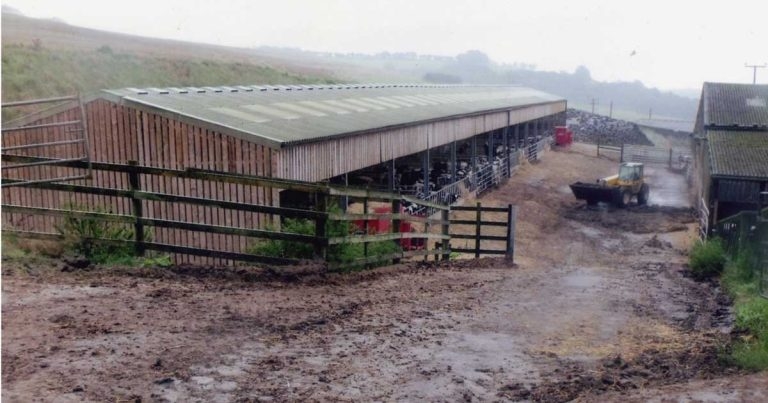
Figure 1. Looking down on part of the main farm showing the open-sided cattle yards.
The incident occurred during April a few years ago and involved a 400-hectare (about 990 acres) farm enterprise spread locally over seven units, and primarily concentrated on the finishing of more than 1,500 beef animals (bulls and steers) annually.
The farm was well established and had successfully undertaken the rearing system for many years. This production centred around a main farm (Figure 1), which primarily bought in well-grown bulls and steers, usually arriving at 10 months to 2 years old. They were housed in groups in open-fronted straw yards.
As animals went for slaughter, the animals remained in the same group without any additions.
The farmer’s records were good, including dates and weights of animals at entry and slaughter. Average weight gain was 1.3kg daily with the yard-reared beef usually leaving the farm for slaughter after about 100 days.
A few of the other farm units also had finishing yards, and in the summer, pastures were used for younger animals and a small herd of about 40 suckler cows producing heifer replacements or animals destined for beef rearing. At the time, the herd was soon due to calve and it was housed at night in a pen on the main farm.
Overall at that time, about 500 cattle were kept indoors and 300 outside. A flock of spring-lambing sheep was kept, and at the time was outside and fed by a feed spinner. A few rams were kept.
Four sows – some with piglets – and a boar were used as a visitor attraction.
About half the acreage was arable, with half of this being used for autumn-sown barley and the remainder distributed equally between wheat and oats. All the cereals and straw were used on farm, and amounts were usually sufficient to prevent the necessity of buying in feed.
Straights and vitamins/minerals were purchased from a couple of sources. Roughage was mainly supplied as straw and also used as bedding, plus in some cases hay or grass silage. Water was from the mains or a bore hole.
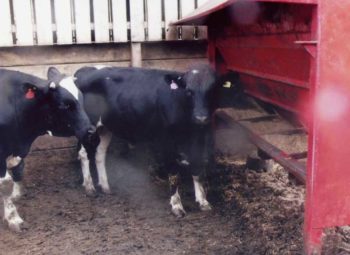
For various reasons, the farmer was persuaded to purchase some feed from a reputable feed company. At 1pm on a Saturday, a load of 19.1 tonnes of pelleted feed was delivered and deposited in front of the home-mixed ration already present in the barn.
About three hours later, the feed hoppers (Figure 2) on the main farm were topped up with the new feed. One pen of 27 cattle did not receive the feed as the hopper was about three-quarters full. On the Friday, a group of five to six-month-old bulls had entered the farm and were fed hay and straw; the pellets were offered on Monday and Tuesday, but rejected by them.
The suckler herd, due to calve in May and June, was housed at night in one of the yards and received 1kg to 2kg per head in open troughs (Figure 3). On another farm that Saturday evening, cattle also received smaller amounts of the feed, as well as the sheep and pigs.
Apparently, at about 4am on the Sunday, the cattle were heard to be bellowing on the main unit. Looking at the animals about two hours later, the farmer found only 50% to 70% of the feed had been consumed, together with all the hay and some of the straw bedding.
Many of the cattle were lying down and apparently in pain, and most showed loose, dark-coloured (variably described as brown or black), bubbly faeces.
The local veterinary practitioner was called, arriving at about 2pm that day, and confirmed the reduced appetite and about 30% scouring with dark dung. He advised keeping a close watch on them.
At the time, both vet and farmer considered that the problem was probably a digestive upset following the sudden change of feed, or acidosis.
Cattle on the other farms received the feed on the Sunday morning in varying small amounts from other farm staff using different vehicles. The amounts fed were considerably lower than those used for finishing on the main unit.
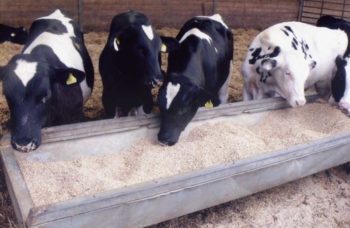
The pellets continued to be offered to the in-lamb and lambed sheep, and to the pigs. Most of both species still rejected the feed. The boar died a few days later and subsequent recorded fertility in the sheep flock was reduced.
The suckler cows developed tender feet, but no lameness; although, the bull became lame in the summer, lost condition and was slaughtered. The farmer complained that several cows, diagnosed as pregnant, did not produce calves, and some that did had little or no milk. Subsequent fertility was poor.
On the Monday, the outdoor cattle and those on other units also showed signs similar to, but milder than those on the main unit. The whole feed batch was used by the Tuesday.
Following a telephone call that day to the feed company by the farmer, a replacement feed batch was provided on the Wednesday with a non-pelleted mix that contained the same ingredients as the suspect feed and apparently no problems arose with this batch.
Subsequently, various communications and visits by the company took place, and the local practitioner also attended at times. Apparently, the feed company received no complaints from other farms that received feed from the same batch run.
By early May, three cattle were slaughtered on humane grounds. In the same month, a group of animals (affected and unaffected) were sent for slaughter and resulted in an animal welfare warning from Trading Standards because the animals showed excessive thirst, and were considered to have been deprived of water.
It transpired that only the suspect feed-exposed cattle were involved. Most of the remaining affected cattle on the farm did not grow well and were turned out to grass.
In May, many of the exposed animals developed varying degrees of lameness (Figures 4 and 5). While it was usually more severe in the hind feet, the front feet were also often involved. By the end of July, eight animals had died and others were euthanised on animal welfare grounds.
More than nine months later, some of the animals were still growing poorly and later slaughtered unfinished .
The suckler herd was claimed to have subsequent infertility problems.
Feed
The farm mixed its own rations using a portable mixer and, at the time of the problem, the feed was said to consist of:
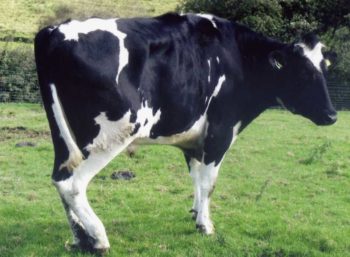
The finishing cattle received about 12kg fresh weight per head of the ration daily.
The introduced manufactured pelleted feed was part of a 170-tonne batch. The ingredients were barley, wheat, sunflower seed extracted, wheat feed, palm kernel expeller, sugar cane molasses, calcium carbonate, rapeseed meal extracted, biscuit and confectionery products, vegetable oils (palm) and vitamin/mineral supplement.
The declared analysis was:
In the latter part of July, the local veterinarian saw 10 chronically affected animals – all poorly grown and with stiff gaits. Two cattle were examined and all four feet were affected with turned up toes and severe white line abscesses. The lower limbs of the lame animals were covered with apparently normal skin. He provided a poor prognosis for them. Faecal sampling was negative for blood.
Subsequently, the feed company arranged visits by various experts, including one in August/September that confirmed the younger exposed cattle appeared worst affected, and the cattle groups not exposed to the feed appeared normal.
In September, a male bovine in fair body condition was euthanised and sent to the veterinary investigation centre. The main lesions found involved the hind feet, but the claws of all four feet showed horizontal grooves in their horn and, from their position, they were calculated to have their onset in April.
Both hind feet were more affected and the left hindleg had a large hole in the sole of the medial claw, lined by black necrotic tissue, with loss of the caudal tip of the third phalanx, and the lateral claw had a white line abscess and marked heel erosion. The right hindleg had under-running of part of the heels, a solar ulcer of the medial claw and white line disease in the lateral claw. The interpretation was of a chronic laminitis – the origin of which could not be determined because of its chronicity.
The liver had pinker areas, but on histological examination these were considered insignificant. Congestion of the abomasum, parts of the jejunum, one kidney and the sclera was observed. Analysis of hair indicated no chronic selenium toxicity was present.
In November, blood samples were taken from nine cattle and on average showed high levels of phosphorus and glutamate dehydrogenase. Albumin and potassium were at the high end of the range. Total protein, globulin, sodium, chloride, total calcium, urea, creatinine, gamma-glutamyl transferase and beta-hydroxybutyrate were mid range. Aspartate aminotransferase, total bilirubin and magnesium were at the lower end of the range.
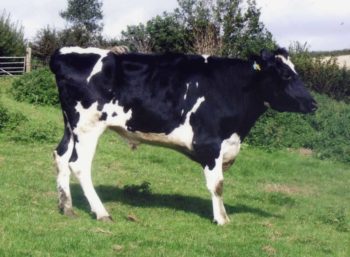
The haematological results showed upper end of the range for red blood cell count, haemoglobin and haematosis (oxygenation of venous blood in the lungs), and mid range for mean corpuscular volume, mean corpuscular haemoglobin and mean corpuscular haemoglobin concentration.
The white blood cell count was high; neutrophils were mid range; platelets, lymphocytes and monocytes were in lower mid range; and eosinophils were in lowest quartile of range. A comment was made that the platelet count appeared normal in film and occasional reactive lymphocytes were present.
In December, a mobility score of 210 unexposed cattle showed 8 (3.6%) between 1 and 3, compared with 23 (42.6%) of 54 in the affected group.
Further veterinary investigation centre postmortem examinations in December of two steers showed lesions of varying degree involving all claws on all limbs with hardship lines, erosion of the heels and some necrosis.
One showed congestion of lung lobules and both kidneys, and the other mild congestion of parts of the abomasum and small intestine. Both had bilateral scleral congestion and mild exophthalmos. The selenium level in one hair sample again did not indicate chronic selenium toxicity.
Analysis in December/January of hoof parings and the suspect feed showed acceptable levels of arsenic, cadmium, lead and mercury. Overall, it was claimed that about:
Initially, the feed company was sympathetic to the suggestion that the problem was most probably due to the feed batch and it was also considered by some experts that a claim should be met on the basis the pelleted feed was most likely at least partially involved. However, in May the following year, the insurance company denied any liability as no diagnosis had been made.
In the September of this second year, you, reader, visit the farm with the objective of attempting to see whether a feasible potential diagnosis could be determined.
You are hampered by the fact neither the feed company nor the farmer have any remaining ration to be analysed. In consequence, it is most unlikely that any potential diagnosis can be confirmed.
All you can do is produce the most credible option based on the available history and signs – both present and absent.
Over to you.